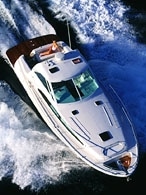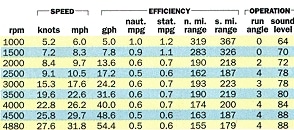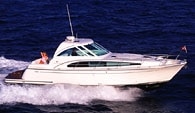
Chris-Craft 40

Chris-Craft 40

Chris-Craft 40 Specs

Chris-Craft 40
Did you give the big photo the once-over? Good. I won’t bore you by waxing poetic for 20 paragraphs about the styling of Chris-Craft’s new Roamer 40, how it harks back to those halcyon days of mahogany planking, brass fixtures, and Graymarine engines. You’ll find plenty of that in lesser publications.
But I will tell you this: Those retro cues, including the flared bow, the raised cabin trunk, and the “sit-pit” rumble seat on the foredeck, combine with the Roamer 40’s innovative deep-V hullform to produce an extraordinarily seaworthy boat with an excess of creature comforts. I’m confident in stating that the Roamer 40 will get up and walk away from most similar-size express cruisers in rough water. The ride is that good.
Has BOATING Magazine finally tested the perfect boat? Well, ummm…no. We still found several things that could be improved. These included features we felt the comparison boats had done better and a few items that are a direct result – a tradeoff – of the very design features that give the Roamer 40 its seakindly performance. For all of that, the Roamer 40 deserves a hard look and a good test drive from anyone in the market for an express cruiser this size. Why? Chiefly because, unlike many modern-production cruisers, it’s designed and built to go head-to-head with the big green sea. In other words, it isn’t some dopey floating RV.
Who Let the Chris-Craft Out?
Maelstrom describes the conditions that met us as we broke St. Lucie Inlet. A ground-swell generated by Hurricane Isaac and a nasty, crossing surface chop whipped up by 20-knot winds collided against the ebbing current of the falling tide. A fat band of white separated sea and sky. We set our feet, gritted our teeth, and eased the levers forward. And you know what? All that foot setting and tooth gritting was unnecessary. With twin 405-hp Crusader 8.2 MPI straight-shaft gasoline inboards propelling us, we cut loose and enjoyed the ride as the Roamer 40 played.
The Highs: Bred for the blue water, and with a protected helm and “sit-pit” forward, it’s a cruiser for all reasons. Sports the cheeriest interior we’ve seen.
The Lows: How about ducting an air-conditioning vent to the helm? Adding a ladder to the engine compartment would make access so much easier.
See for yourself. Throttle up to 26 mph and the Roamer 40 rises to meet head seas without slamming. Down seas? It climbed the backside with torquey authority, thanks to deep gears and big props. I’d love to run this rig with diesel power (twin 370-bhp Volvo Penta 63Ps cost $53,585). Despite the quartering wind and chop, it tracked straight without rudder or prop cavitation. In the trough? Stable as a table. Don’t misunderstand – the Roamer 40 still went up and down. Some spray flew over the hardtop. Testing a 40′ cruiser at speeds up to 30 mph in rough water will do that. What’s important, and so uncommonly good, is that we felt safe and in control while doing it. The Roamer 40’s ride is one a fishboat would envy. In fact, John Beknatel, of C. Raymond Hunt Associates, the firm that designed the Roamer 40 for Chris-Craft, described the boat as “a cruiser with a fishboat bottom.”
Check out the bow’s flare. The reserve buoyancy it provides resists the tendency to stuff a wave – or worse, pitchpole. Look closer: The hull tapers to a whisper. This fine entry helps it rise to meet waves smoothly. Check the waterline. The chine is submerged – “wet” – for over two-thirds of the Roamer 40’s waterline length. Read: stability. Look again. See the notch below the boat stripe? The Roamer 40’s bottom produces enough lift that Chris-Craft could narrow the waterline beam to 12′ without losing the ability to keep the bow up and maintain an easy, controlled 17-mph minimum planing speed. Along with the Roamer 40’s constantly variable deadrise, which tapers from 20 degrees at the transom to 55 degrees at the entry, the skinny waterline beam allows you to run soft through the slop. And unlike most modern cruisers, its swim platform is not an overhang. It extends the running surface. The Roamer 40 floats on a 43′ waterline. This enhances lift, stability, and weight distribution. Stow a waterbike aft and the Roamer 40 won’t squat. Straight-shaft inboard power was selected over space-saving V-drives for the same reason: Keep the center of gravity low and centered or ride and handling might suffer.
The fine entry, bow flare, and narrow waterline beam are all characteristics of classic yachts, built before the marketeers took over. They were incorporated because they had a purpose. And they still do.
If You Wanna Play…
Consider the raised cabin trunk. It provides lots of headroom while allowing for a wide sidedeck. Deploying fenders and spring lines is safe and easy. However, like the fine entry, bow flare, and straight-shaft power, this feature eats up interior space in comparison to cruisers with flush foredecks, fuller bows, and V-drive power. The forward stateroom’s narrower than the norm and the aft stateroom is a bit shorter. Stowage cabinets and the salon lounge are shallower, too.
Yet the Roamer 40 possesses the cheeriest interior I’ve seen in this size range. Why? Stainless-steel-framed windows run the length of its cabin. These let in the sun and provide a water view for everyone within. There’s no cave-like feeling here. Exclusively designed, the windows feature wide flanges and scuppers to ensure against leaks. Also, there’s a teak-and-holly sole, maple bulkheads, and navy blue faux-leather upholstery. The brushed-stainless-steel galley appliances look cool. Bullnosed Corian counters and reverse-flange sinks grace both heads. The forward stateroom’s island berth is topped by an innerspring mattress, not a pad. There’s top quality throughout.
Of course, you’ll be hard-pressed to keep your guests belowdecks aboard the Roamer 40. Its standard hardtop, which provided excellent weather protection during our test, lets you bring the party topside. And wild horses couldn’t keep most folks from lounging in the deep, 6′-long sit-pit on the bow.
Home Alone?
Chris-Craft isn’t the only manufacturer that made “form follows function” its mantra. Formula’s 41PC ($317,900 powered by 400-hp MerCruiser 8.2L MPI inboards) features a svelte waterline beam and a fine entry, and Tiara’s 4100 ($392,360 with twin 435-bhp CAT 3208 diesel inboards) has inboard power and wide sidedecks. Direct comparisons? There’s no production boat offered that mirrors the Roamer 40. But the Formula and Tiara are also amenity-filled, true offshore performers that use high construction standards, including fiberglassed and fastened hull-to-deck joints, through-bolted engine mounting, and full-height structural bulkheads. We’d like to see Chris-Craft put an a/c register at the helm as aboard the Tiara. After all, both the a/c and hardtop are standard. And adding a ladder to climb into the engine room would make service easier than the drop-in method we used to install the test gear.
Nonetheless, if, like me, you want a cruiser that actually cruises instead of one that’s simply a floating party platform, test drive Chris-Craft’s Roamer 40.
Last Word: I’ve spent thousands of hours offshore, and I’d cruise this baby anywhere.
LOA…………43’6″
Beam……….14’0″
Draft……….3’2″
Displacement (lbs., approx.)……….20,000
Transom deadrise…20°
Bridge clearance…12’0″
Minimum cockpit depth …………..2’10”
Max. cabin headroom …………6’8″
Fuel capacity (gal.)…340
Water capacity (gal.)..90
Price (w/standard power) ………………$392,995
Price (w/test power) ……………….$401,900
Standard Power: Twin 420-hp Volvo Penta 8.1 GSi V-8 gasoline inboards.
Optional Power: Twin 405-hp Crusader 8.2L MPI gasoline inboards; twin Cummins or Volvo Penta diesel inboards to 710 bhp.
Test Boat Power: Twin 405-hp Crusader 8.2L MPI V-8 gasoline inboards with 502 cid, 4.47″ bore x 4.00″ stroke, swinging 23″ x 23″ four-bladed Nibral props through 2.68:1 reductions.
Standard Equipment(major items): Fiberglass hardtop; ss anchor plate; windlass w/ 200′ rode and foot switches; anchor washdown; spotlight; cockpit wetbar w/refrigerator and icemaker; compass; GPS; VHF radio; Tridata (depth-speed-log); coffeemaker; glass and bottle racks; microwave; dual-voltage refrigerator; dual-burner stove; phone/fax plug; 2 TV/VCRs; AM/FM/CD stereo; 2 enclosed heads w/showers; 28,000-Btu a/c w/reverse-cycle heat; high water alarm; CO detector; dual 30-amp shorepower; 7.3kW genset; engine room washdown; auto. fire suppression; crossover fuel system.









